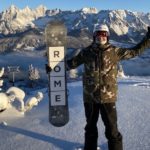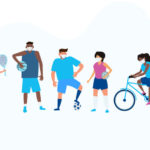Organized sports and COVID-19: Are we there yet?

After a long, challenging year, many student athletes have returned to play this spring with joy and relief. But, organized sports have been linked to COVID-19 outbreaks in several states. The CDC warns that those who play close-contact and inside sports are at very high risk of infection. Even as they relax mandates to wear masks outdoors, public health officials say that it’s too soon to let down our guards.
“We now have some important tools to reduce the risk of COVID-19, especially the vaccines,” says Dr. Melanie Dubois, a pediatric infectious disease specialist. “As the vaccination rollout continues in adults and we await results of clinical trials for vaccines in younger children, we must remain vigilant and continue to abide by the recommended public health measures.”
Athletes want to return to play. Parents and coaches want to avoid another lost season. Is it possible to balance the positive effects of sports with the risks of the pandemic? Here, Dr. Dubois and Dr. Gian Corrado, a physician in the Sports Medicine Division, answer questions about COVID-19, organized sports, and why precautions remain vitally important.
What makes organized sports risky?
The nature of sports can make it difficult to limit the risk of infection. Moving around a court, breathing hard, and cheering after a great play all provide the virus opportunities to spread. Close contact between players and lack of fresh air make some sports even higher risk than others. Wrestling and basketball, for instance, are typically played indoors with athletes frequently coming face to face. It’s easier to maintain physical distance in sports like tennis and swimming. When played outdoors, the risk of infection drops even lower.
But even if a sport is relatively safe, taking unnecessary risks can quickly turn a low-risk sport into a high-risk situation. “Many of the activities that happen around sports, such as parents gathering in large groups without masks before a game or kids carpooling to a tournament without masks, increase the risk for the whole team,” says Dr. Corrado.
I play an outdoor sport. Do I really have to wear a mask?
This week, both the CDC and the state of Massachusetts relaxed their guidelines around mask wearing outside – with a couple of catches. The CDC has said people can walk, bike, or run outside without a mask as long as they do so alone or with members of their household. But those who are not fully vaccinated should continue to wear masks at outdoor gatherings with other unvaccinated people. And everyone, whether vaccinated or not, should wear masks at indoor events and at crowded outdoor events. This includes sports events.
“This is definitely a positive step we’ve all been looking forward to,” says Dr. Dubois. “Studies have shown that outdoor activities are safer than indoor activities, as the risk of transmission of COVID-19 is lower outside. But we need to treat it as exactly that, one step in a series of steps to return to normal activities.”
Public health recommendations for athletes will be updated throughout the next several months. Parents, coaches, and athletes should check the CDC website frequently for the latest guidelines.
Masks remain recommended for athletes, parents, coaches, sports staff, officials, and spectators. Wearing a mask protects other team members, especially those who have not yet been vaccinated and those with conditions like asthma that make them more vulnerable. In addition, it is important to encourage physical distancing when possible. Parents, coaches, and athletes should continue to follow CDC and local guidelines for the latest recommendations.
What do the COVID-19 variants mean for athletes?
Over the winter, several COVID-19 virus variants were detected in the United States. The most prominent of these was the B.1.1.7. variant, also known as the U.K. variant, because it first appeared in the United Kingdom. Studies have shown that the B.1.1.7. variant is more transmissible (easily passed from person to person).
“That’s a key concern,” says Dr. Dubois. “Early data show that the COVID-19 vaccines are effective against the current variants to prevent severe COVID-19 disease. Therefore, it is more important than ever to get a COVID-19 vaccine when available to you, choose safer activities, and follow preventive measures to protect yourself, your teammates, families, and friends.”
What can I do to support my team during COVID-19?
Dr. Corrado sees alarming signs that many teams have given up on COVID-19 precautions altogether. Fewer players are wearing masks and more parents are organizing social events before and after games. As good as it may feel to do normal things again, a false sense of security could make the pandemic last even longer. “Kids need to be outside playing and running around,” says Dr. Corrado. “That’s why it’s too soon to stop taking precautions. We need to prevent outbreaks that would force our kids into quarantine.”
Preventing COVID-19 is a team sport
As long as COVID-19 remains a serious risk for athletes, precautions should be part of sporting life. Parents, coaches, and athletes can all play a role in prevention so the games can go on.
Parents: Be a role model
- Cooperate with the coach or league’s guidelines.
- Wear masks at your kids’ sporting events.
- Limit the number of family members who attend games.
- If you feel sick, don’t attend the game or practice.
Coaches: Be a leader
- Know and follow advice from the CDC to provide a safe environment.
- Set clear guidelines and communicate them to your athletes and their families.
- Encourage behaviors that reduce the spread of COVID-19, such as mask wearing and physical distancing.
- Schedule practices and games outdoors. If that’s not possible, open windows and make sure the air is circulated.
Athletes: Be a team player
- Maintain physical distance from other players as much as possible.
- Wear your mask to protect yourself and your teammates.
- Bring your own equipment to practices and wash your hands often.
- Stay home if you’re sick.
Learn more about Boston Children’s response to COVID-19 and our Sports Medicine Division.
Related Posts :
-

Returning to sports after having COVID-19
Mikey LaCroix, age 23, competes in snowboard cross for the U.S. Snowboard Team. In late 2020, he was diagnosed with COVID-19 ...
-

Could returning to sports after COVID-19 harm kids’ mental health?
After a year away from playing, athletes everywhere are excited to jump back into the sports they love. And for ...
-

COVID-19 and sports: Is it safe to play again?
It was hard on athletes when COVID-19 forced sports to shut down last spring, but at least everyone was in ...
-

Sports injuries: Why ignoring pain is bad for athletes
“No guts, no glory.” “No pain, no gain.” “Rub some dirt in it.” Sports clichés like these encourage young ...





